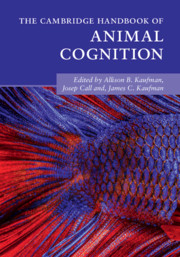Book contents
- The Cambridge Handbook of Animal Cognition
- The Cambridge Handbook of Animal Cognition
- Copyright page
- Dedication
- Contents
- Figures, Tables, and Boxes
- Contributors
- Acknowledgments
- Introduction
- Part I Communication and Language
- Part II Memory and Recall
- Part III Social Cognition
- 11 Social Cognition Overview
- 12 Proximate and Ultimate Mechanisms of Cooperation in Fishes
- 13 Evolutionary and Neural Bases of the Sense of Animacy
- 14 Raven Social Cognition and Behavior
- 15 Reciprocal cooperation – Norway rats (Rattus norvegicus) as an example
- 16 Exploring the Social Minds of Elephants
- 17 Dolphin Social Cognition
- 18 Mirror Self-Recognition
- Part IV Social Learning and Teaching
- Part V Numerical and Quantitative Abilities
- Part VI Innovation and Problem-Solving
- Index
- References
15 - Reciprocal cooperation – Norway rats (Rattus norvegicus) as an example
from Part III - Social Cognition
Published online by Cambridge University Press: 01 July 2021
- The Cambridge Handbook of Animal Cognition
- The Cambridge Handbook of Animal Cognition
- Copyright page
- Dedication
- Contents
- Figures, Tables, and Boxes
- Contributors
- Acknowledgments
- Introduction
- Part I Communication and Language
- Part II Memory and Recall
- Part III Social Cognition
- 11 Social Cognition Overview
- 12 Proximate and Ultimate Mechanisms of Cooperation in Fishes
- 13 Evolutionary and Neural Bases of the Sense of Animacy
- 14 Raven Social Cognition and Behavior
- 15 Reciprocal cooperation – Norway rats (Rattus norvegicus) as an example
- 16 Exploring the Social Minds of Elephants
- 17 Dolphin Social Cognition
- 18 Mirror Self-Recognition
- Part IV Social Learning and Teaching
- Part V Numerical and Quantitative Abilities
- Part VI Innovation and Problem-Solving
- Index
- References
Summary
Many animals cooperate even with unrelated individuals in various contexts, like providing food or allogrooming others. One possibility to explain the evolution of such apparently altruistic behaviour is reciprocity. In reciprocal cooperative interactions, individuals help those partners that have been previously cooperative and therefore exchange favours. This conditional help follows rules like “I help you because you helped me.” These rules are often assumed to be so cognitively demanding that they may be limited to humans. In this chapter, I will shed light on the cognitive underpinnings of reciprocal cooperation by reviewing work on one of the yet best-studied animal in this research area, the Norway rat (Rattus norvegicus). Various studies have demonstrated that Norway rats reciprocally exchange different goods and services. They most likely form attitudes toward social partners that are based on the cooperation level of the last encounter, which they remember over long time spans. Cooperation decisions based on attitudes appear cognitively less complex than calculations of received and given favors. Thus, reciprocal cooperation based on this cognitive mechanism might be in fact more widespread among nonhuman animals than commonly believed.
- Type
- Chapter
- Information
- The Cambridge Handbook of Animal Cognition , pp. 343 - 361Publisher: Cambridge University PressPrint publication year: 2021
References
- 4
- Cited by



